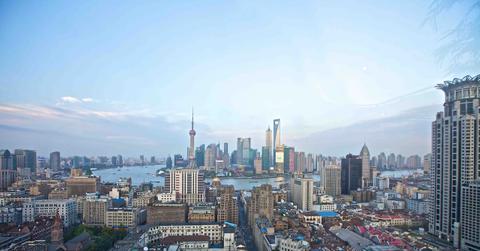China Launches Initiative For 'Sponge Cities' To Combat Flooding
Retro-fitting older urban infrastructures is creating new ways to deal with flooding in China's vast urban sprawl, as their low-lying grounds make the area particularly vulnerable to dangerous and damaging floods.
Updated May 24 2019, 12:00 a.m. ET
China is a country which has experienced rapid industrialization within the last century, with a number of low-lying areas that make it vulnerable to flooding. For example, in 2016, train stations, a football field and roads were completely underwater in the Chinese city of Wuhan. Certain places are also struggling with drought and water management, with one drought this year recorded as the worst in history, according to the New York Times.
In 2015, China launched a "sponge city" initiative with a very ambitious goal. By 2020, 70 percent of all rainwater should be absorbed in at least 80 percent of urban areas in all of China. GreenBiz reports that the program was launched in 16 cities around the country, with hundreds of millions of dollars going to retrofit infrastructures already in place in bigger cities.
The Guardian interviewed local experts on the efficiency of the sponge cities plans in 2016, most of whom pointed out all the ways that prioritizing recycling and absorbing water can benefit communities, business, and the environment everywhere. Michael Zhao, an expert in water management who works for global urban designers group Arup in Shanghai, explained how delays addressing the issue have already made it more problematic than necessary.
“In China the climate is bringing more rain in summer. From June to September there will be high density rainfall which is bringing up urban planning problems,” said Zhao. “There’s already been very serious flooding for four or five years each summer. You will see flooding in more and more cities. As urbanization brings more people to those cities the problem becomes worse and worse.”
So what do these retro-fittings entail? GreenBiz writes that roofs are outfitted with water absorbent gardens, healing wetlands are developed along waterways, and permeable pavements have been installed to absorb runoff and modulate temperatures. It also requires a fair amount of regulation, which means that the government is struggling to find funding for the laborious process of corralling people to comply with new rules for building and expanding. There is also limited interest from private investors, who may be skeptical of the financial return in these projects.
Zhou explains that, “from our experience working with pilot cities governments and local design institutes, there are both technical and management issues, depending on how the local pilot cities manage those challenges; some cities move faster, some comparably slow.”
A year later, and it looks like China is still struggling with financial issues that may keep it form hitting its 2020 goal. But it shows what kind of changes can be actualized with government intervention to create a sustainable future in the urban environments so many people depend on.
